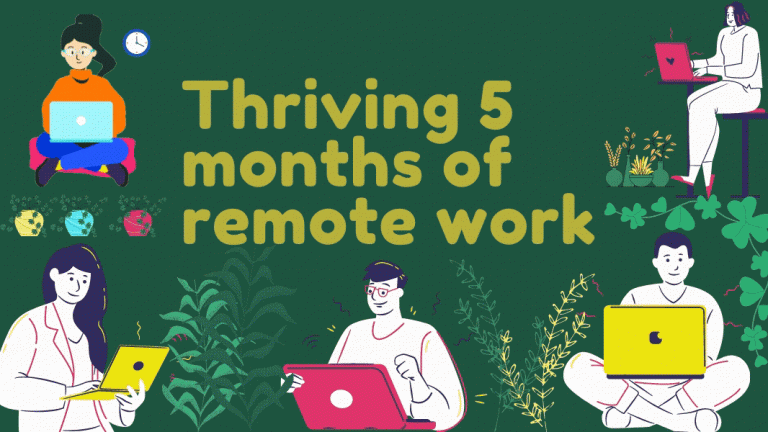Last month we crossed the 100-day mark on our work from home scenario. We sent all of our employees to their homes way before the government-mandated lockdown, ensuring a smooth transition to going fully remote. This also made it possible for them to take their hardware home, some of which were bulky. As the pandemic appeared to subside for a while, we were planning to bring back everyone slowly to the office, but as it got worse, all plans were dropped.
And now we have been fully remote for almost five months, and we are right on track with no delays in releases and with our clients happy. This was possible mostly because we were fully remote ready, with our agile methodology and the use of project management tools. So we figured we’ll tell you how we thrived during the first 100 days of lockdown.
Use of agile methodology.
We have been using agile software development methodologies since our beginning. It helped us to bring together client expectations into our product without delays. We empowered our developers to make decisions by themselves, assign tasks to each other, and we had daily stand-ups to brief each other about our work.
Now, proponents of agile agree that face to face communication is always the best. And obviously, when everyone is working from home, that is impossible. Earlier, when one of our developers were working from home for a day or two, they used to send their briefings as messages, but since that is not practical now, we have switched to calls over teams. And apart from that, there’s no difference in our daily standups.
While we did have a whiteboard to mark the progress of our development cycles, we have relied on Clickup and Jira to give detailed info. Our sprints usually last one or two weeks and having a detailed board lets every team member to monitor the tasks they have to do.
This actually became much more useful and served as an online whiteboard.
Project management tools.
Microsoft Teams and Slack
Microsoft Teams have always been our communication tool and helped us avoid walking 30 feet or shouting across the room every time we needed to say something to someone, back when we were working in the office. On a serious note, it was really handy to show something to the entire team, or to share files, and to keep track of daily tasks. We also use Slack for communication.
But it became even more useful once we went remote. One single platform to communicate, both messaging and calling, to share files quickly. Things that were shown to colleagues by bringing their laptop to them now changed to a series of screenshots, or screen sharing.
Gitlab
As with any software development cycle, Gitlab plays a major role in our development activities too. And while working remotely (and even otherwise), Gitlab helps with continuous integration and continuous deployment.
Changes in the way we communicate
And while there were delays and communication issues earlier into the lockdown, later it became even better than it was before. Maybe it’s just me, but the way we communicated sort of evolved, to make better use of time, and to avoid delays.
For example, earlier, when I wanted to get an opinion on a design I made, for blog banner, or for an Instagram post, I used to simply show them to my colleague, get their opinion, and change it accordingly. But this back and forth over messages lead to delays when the other person was unavoidably busy. Each iteration took too long. Now I simply give 4 or 5 options, and simply say pick one. I’m able to plan accordingly, they are able to give quick feedback, and delays are reduced.
Something else I noticed was the absence of ‘nods’. I had never considered how important gestures and cues are important for communication. Since most calls are audio-only, everyone else mutes, when someone’s talking. And the person who is explaining something, they’re left wondering if everyone agrees, or if everyone’s even there, or if they got disconnected. This has left many of us asking “you there?” and often created a mad scramble to hit the unmute button to say “Yes, I’m listening, continue”.
And sometimes, we just have to sit back and chill with the team.
All work and no play makes the entire team a dull team. The best part of working from the office was the time probably spent simply talking. It didn’t matter how much work we had, everyone made time to just talk or go get coffee or tea from the break room, and just relax. One moment everyone was working, and the next, everyone was talking about a new feature on a phone, or about whatever was going on at their homes.
Personally, this made me more productive. And I’m sure everyone felt the same way. But with everyone working from home, the small talk was lost. There were no animated discussions in the break room about whether android or iOS was better(somehow that never happened even when we were working from the office). And the weekly games hosted by our HR was gone.
But of course, our HR guy was not going to just let us work all week long. He started hosting online games. I’ll be honest, I was a little sceptical about team games online. I mean, we can’t exactly throw darts online, can we?
Instead, he had us running all over our homes looking for objects to hold in front of the camera and guess song lyrics and movie names.
Recently we also restarted our weekly seminars, albeit over Microsoft Teams. And when one guy is presenting a seminar to 30 or so people, that mad scramble to hit the mute button happened more than once.



